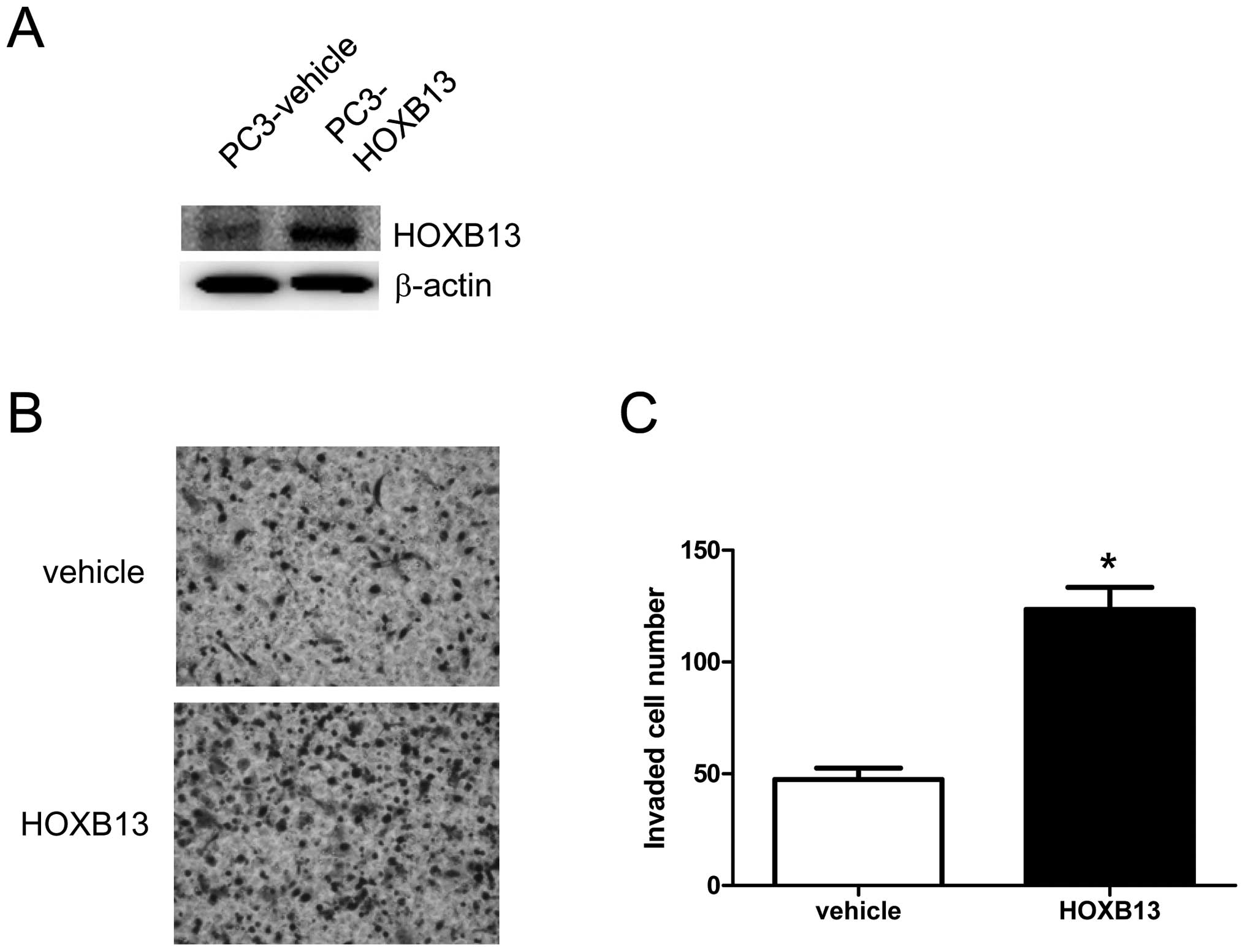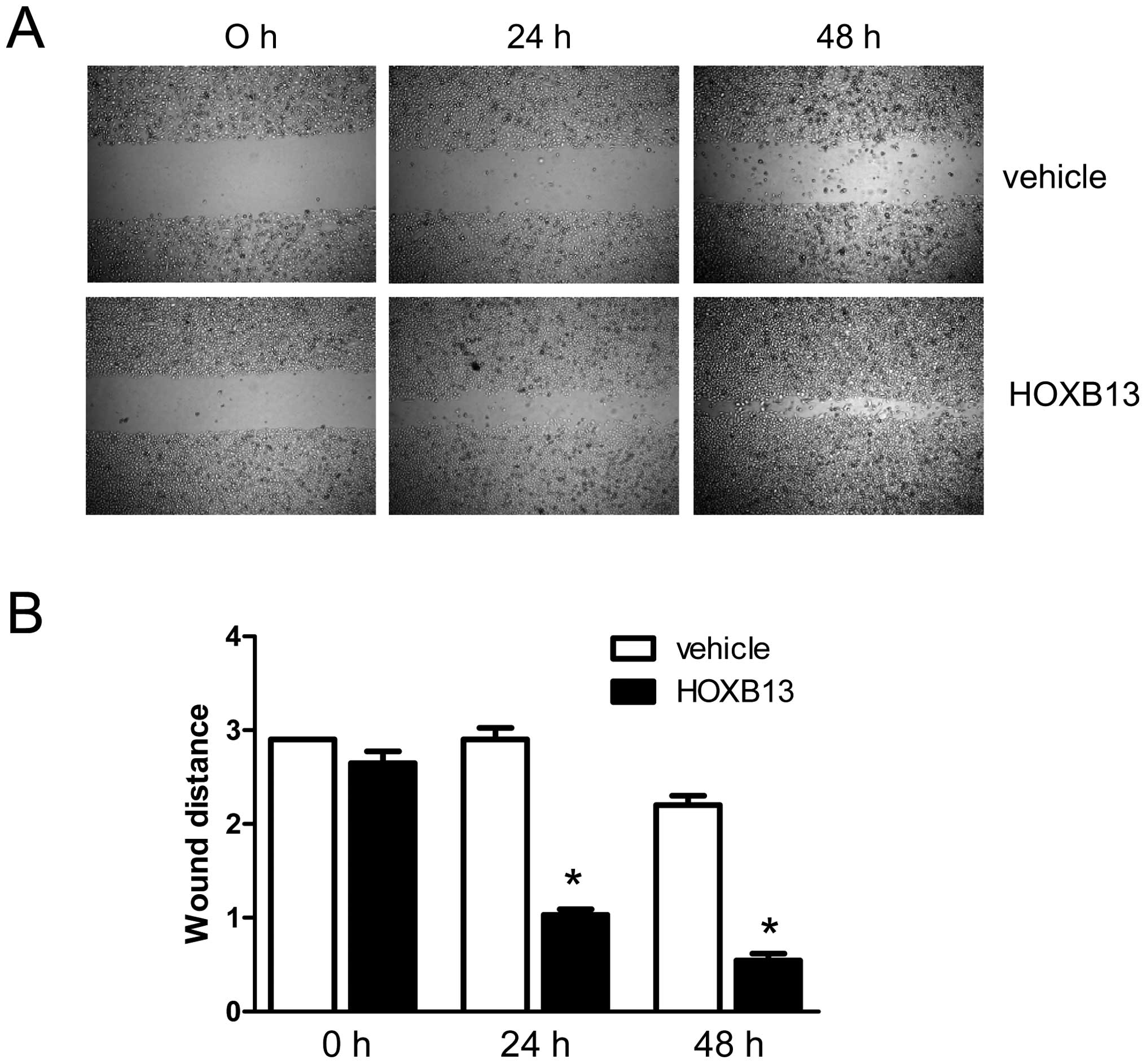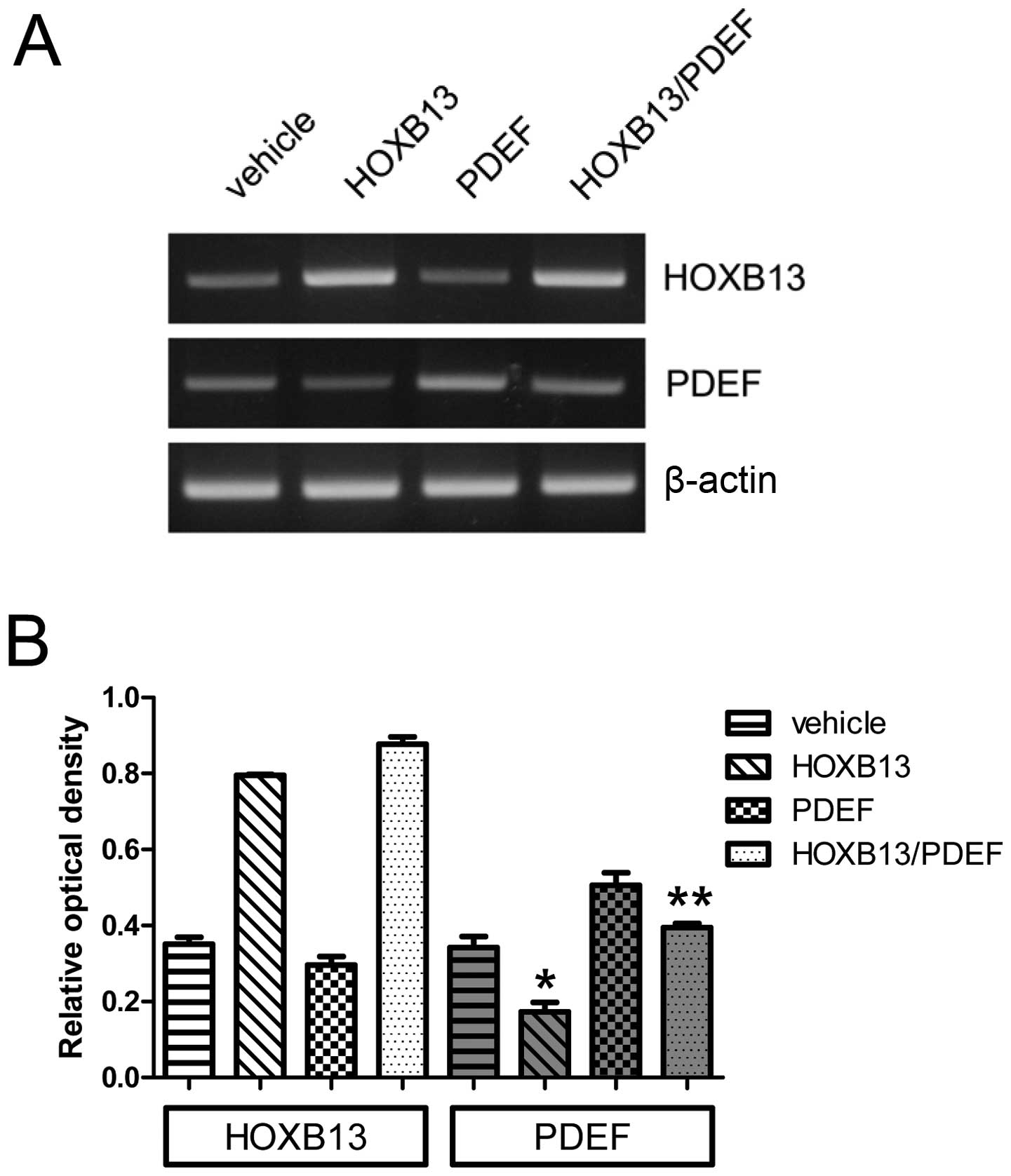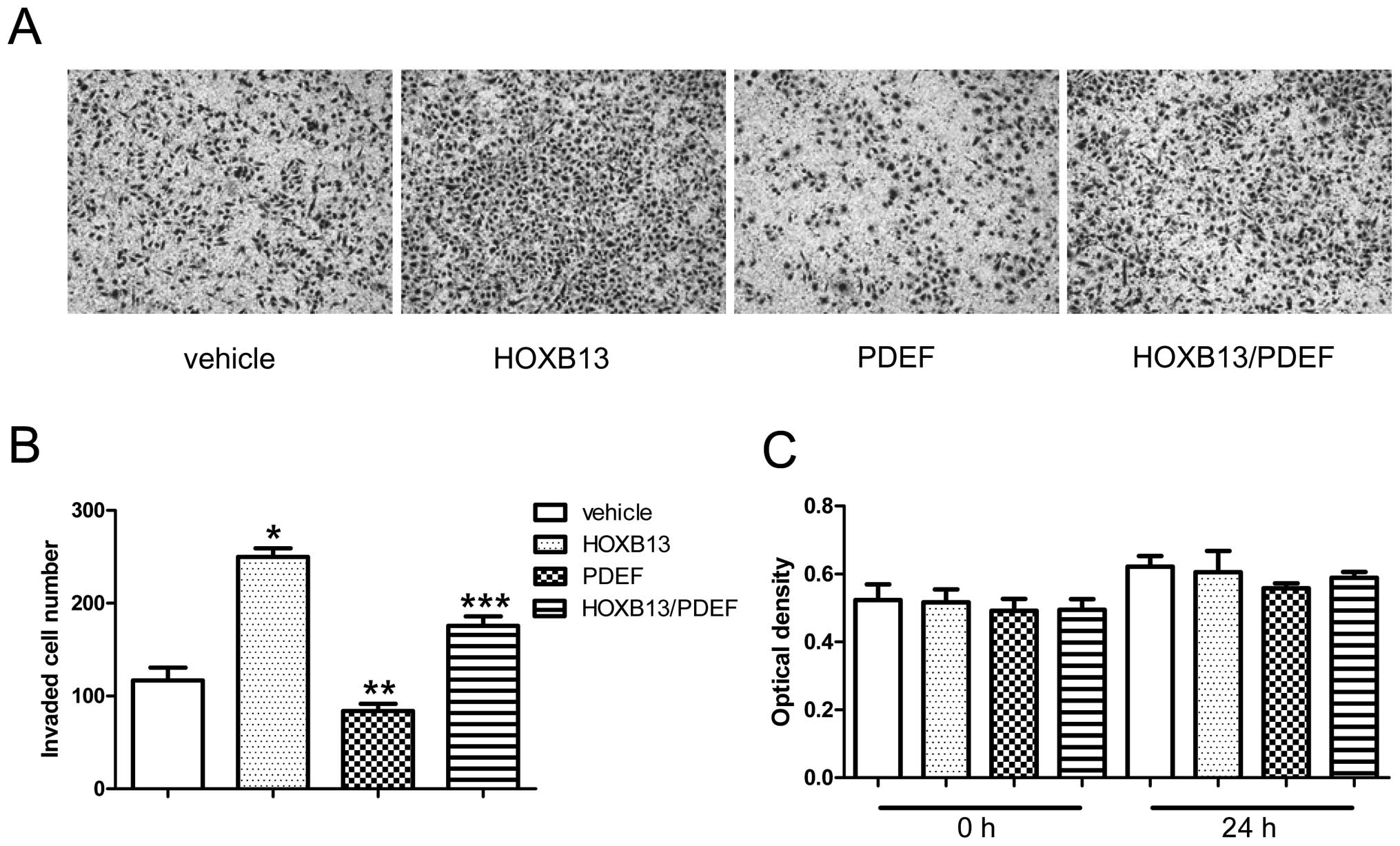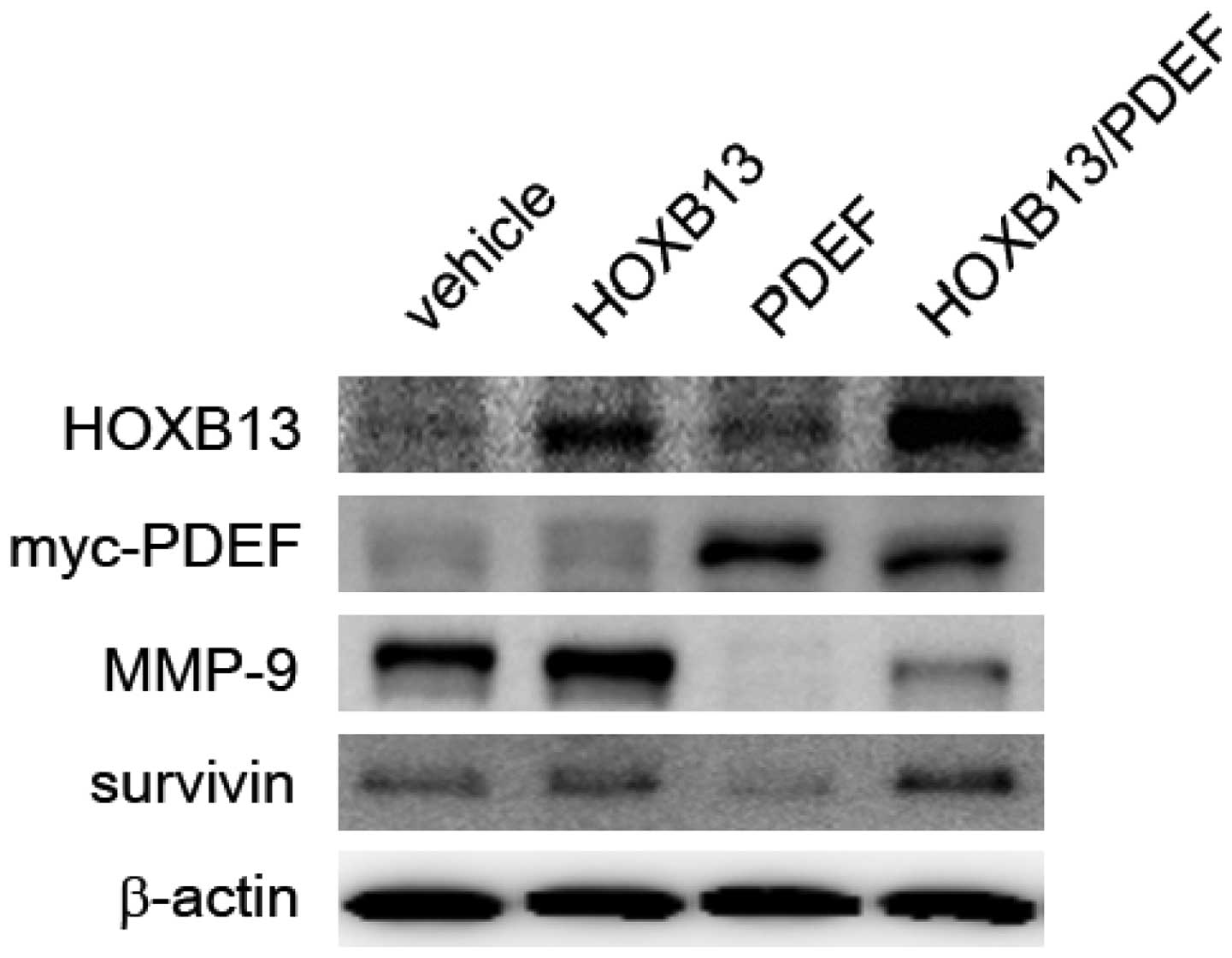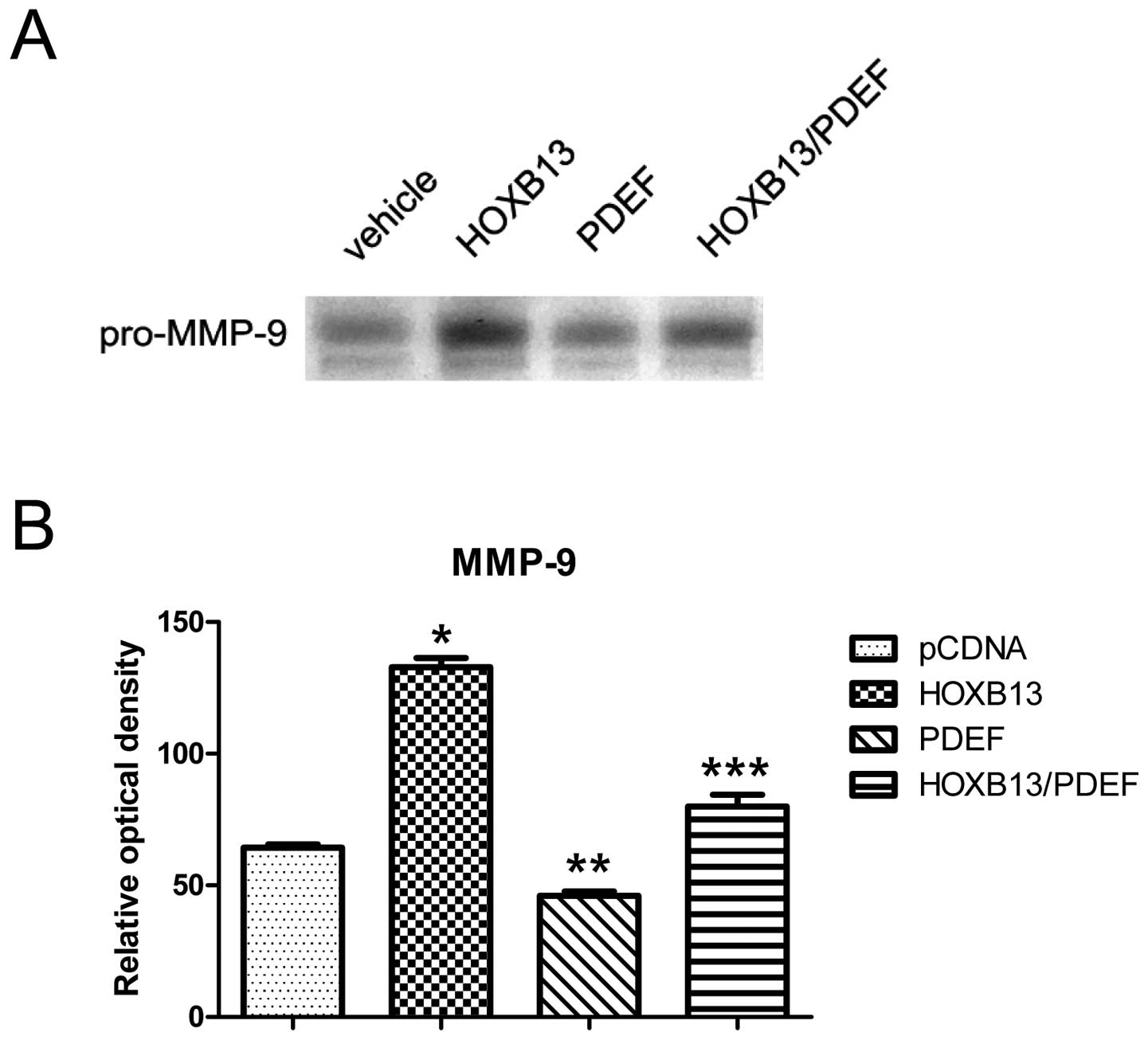|
1
|
Sreenath T, Orosz A, Fujita K and
Bieberich CJ: Androgen-independent expression of hoxb-13 in the
mouse prostate. Prostate. 41:203–207. 1999. View Article : Google Scholar : PubMed/NCBI
|
|
2
|
Ma XJ, Wang Z, Ryan PD, et al: A two-gene
expression ratio predicts clinical outcome in breast cancer
patients treated with tamoxifen. Cancer Cell. 5:607–616. 2004.
View Article : Google Scholar
|
|
3
|
Miao J, Wang Z, Provencher H, et al:
HOXB13 promotes ovarian cancer progression. Proc Natl Acad Sci USA.
104:17093–17098. 2007. View Article : Google Scholar : PubMed/NCBI
|
|
4
|
Zhao Y, Yamashita T and Ishikawa M:
Regulation of tumor invasion by HOXB13 gene overexpressed in human
endometrial cancer. Oncol Rep. 13:721–726. 2005.PubMed/NCBI
|
|
5
|
Edwards S, Campbell C, Flohr P, et al:
Expression analysis onto microarrays of randomly selected cDNA
clones highlights HOXB13 as a marker of human prostate cancer. Br J
Cancer. 92:376–381. 2005. View Article : Google Scholar : PubMed/NCBI
|
|
6
|
Jung C, Kim RS, Lee SJ, Wang C and Jeng
MH: HOXB13 homeodomain protein suppresses the growth of prostate
cancer cells by the negative regulation of T-cell factor 4. Cancer
Res. 64:3046–3051. 2004. View Article : Google Scholar : PubMed/NCBI
|
|
7
|
Jung C, Kim RS, Zhang HJ, Lee SJ and Jeng
MH: HOXB13 induces growth suppression of prostate cancer cells as a
repressor of hormone-activated androgen receptor signaling. Cancer
Res. 64:9185–9192. 2004. View Article : Google Scholar : PubMed/NCBI
|
|
8
|
Kim SD, Park RY, Kim YR, et al: HOXB13 is
co-localized with androgen receptor to suppress androgen-stimulated
prostate-specific antigen expression. Anat Cell Biol. 43:284–293.
2010. View Article : Google Scholar : PubMed/NCBI
|
|
9
|
Kim YR, Oh KJ, Park RY, et al: HOXB13
promotes androgen independent growth of LNCaP prostate cancer cells
by the activation of E2F signaling. Mol Cancer. 9:1242010.
View Article : Google Scholar : PubMed/NCBI
|
|
10
|
Kim YR, Kim IJ, Kang TW, et al: HOXB13
downregulates intracellular zinc and increases NF-kappaB signaling
to promote prostate cancer metastasis. Oncogene. 7–Oct;2013.(Epub
ahead of print). View Article : Google Scholar : 2013.
|
|
11
|
Sharrocks AD, Brown AL, Ling Y and Yates
PR: The ETS-domain transcription factor family. Int J Biochem Cell
Biol. 29:1371–1387. 1997. View Article : Google Scholar : PubMed/NCBI
|
|
12
|
Clark JP and Cooper CS: ETS gene fusions
in prostate cancer. Nat Rev Urol. 6:429–439. 2009. View Article : Google Scholar : PubMed/NCBI
|
|
13
|
Kumar-Sinha C, Tomlins SA and Chinnaiyan
AM: Recurrent gene fusions in prostate cancer. Nat Rev Cancer.
8:497–511. 2008. View
Article : Google Scholar : PubMed/NCBI
|
|
14
|
Tomlins SA, Bjartell A, Chinnaiyan AM, et
al: ETS gene fusions in prostate cancer: from discovery to daily
clinical practice. Eur Urol. 56:275–286. 2009. View Article : Google Scholar : PubMed/NCBI
|
|
15
|
Oettgen P, Finger E, Sun Z, et al: PDEF, a
novel prostate epithelium-specific ets transcription factor,
interacts with the androgen receptor and activates
prostate-specific antigen gene expression. J Biol Chem.
275:1216–1225. 2000. View Article : Google Scholar : PubMed/NCBI
|
|
16
|
Johnson TR, Koul S, Kumar B, et al: Loss
of PDEF, a prostate-derived Ets factor is associated with
aggressive phenotype of prostate cancer: regulation of MMP 9 by
PDEF. Mol Cancer. 9:1482010. View Article : Google Scholar : PubMed/NCBI
|
|
17
|
Gu X, Zerbini LF, Otu HH, et al: Reduced
PDEF expression increases invasion and expression of mesenchymal
genes in prostate cancer cells. Cancer Res. 67:4219–4226. 2007.
View Article : Google Scholar : PubMed/NCBI
|
|
18
|
Turner DP, Findlay VJ, Moussa O, et al:
Mechanisms and functional consequences of PDEF protein expression
loss during prostate cancer progression. Prostate. 71:1723–1735.
2011. View Article : Google Scholar
|
|
19
|
Ghadersohi A, Pan D, Fayazi Z, Hicks DG,
Winston JS and Li F: Prostate-derived Ets transcription factor
(PDEF) downregulates survivin expression and inhibits breast cancer
cell growth in vitro and xenograft tumor formation in vivo. Breast
Cancer Res Treat. 102:19–30. 2007. View Article : Google Scholar : PubMed/NCBI
|
|
20
|
Lynch CC and Matrisian LM: Matrix
metalloproteinases in tumor-host cell communication.
Differentiation. 70:561–573. 2002. View Article : Google Scholar : PubMed/NCBI
|
|
21
|
Zhang M, Latham DE, Delaney MA and
Chakravarti A: Survivin mediates resistance to antiandrogen therapy
in prostate cancer. Oncogene. 24:2474–2482. 2005. View Article : Google Scholar : PubMed/NCBI
|
|
22
|
Feldman RJ, Sementchenko VI, Gayed M,
Fraig MM and Watson DK: PDEF expression in human breast cancer is
correlated with invasive potential and altered gene expression.
Cancer Res. 63:4626–4631. 2003.PubMed/NCBI
|
|
23
|
Feldman RJ, Sementchenko VI and Watson DK:
The epithelial-specific Ets factors occupy a unique position in
defining epithelial proliferation, differentiation and
carcinogenesis. Anticancer Res. 23:2125–2131. 2003.
|
|
24
|
Moussa O, Turner DP, Feldman RJ, et al:
PDEF is a negative regulator of colon cancer cell growth and
migration. J Cell Biochem. 108:1389–1398. 2009. View Article : Google Scholar : PubMed/NCBI
|
|
25
|
Turner DP, Findlay VJ, Kirven AD, Moussa O
and Watson DK: Global gene expression analysis identifies PDEF
transcriptional networks regulating cell migration during cancer
progression. Mol Biol Cell. 19:3745–3757. 2008. View Article : Google Scholar : PubMed/NCBI
|
|
26
|
Turner DP, Moussa O, Sauane M, Fisher PB
and Watson DK: Prostate-derived ETS factor is a mediator of
metastatic potential through the inhibition of migration and
invasion in breast cancer. Cancer Res. 67:1618–1625. 2007.
View Article : Google Scholar : PubMed/NCBI
|
|
27
|
Schaefer JS, Sabherwal Y, Shi HY, et al:
Transcriptional regulation of p21/CIP1 cell cycle inhibitor by PDEF
controls cell proliferation and mammary tumor progression. J Biol
Chem. 285:11258–11269. 2010. View Article : Google Scholar : PubMed/NCBI
|
|
28
|
Findlay VJ, Turner DP, Yordy JS, et al:
Prostate-derived ETS factor regulates epithelial-to-mesenchymal
transition through both SLUG-dependent and independent mechanisms.
Genes Cancer. 2:120–129. 2011. View Article : Google Scholar : PubMed/NCBI
|
|
29
|
Ma XJ, Hilsenbeck SG, Wang W, et al: The
HOXB13:IL17BR expression index is a prognostic factor in
early-stage breast cancer. J Clin Oncol. 24:4611–4619. 2006.
View Article : Google Scholar : PubMed/NCBI
|
|
30
|
Ghadersohi A, Odunsi K, Zhang S, et al:
Prostate-derived Ets transcription factor as a favorable prognostic
marker in ovarian cancer patients. Int J Cancer. 123:1376–1384.
2008. View Article : Google Scholar : PubMed/NCBI
|
|
31
|
Ghadersohi A, Sharma S, Zhang S, et al:
Prostate-derived Ets transcription factor (PDEF) is a potential
prognostic marker in patients with prostate cancer. Prostate.
71:1178–1188. 2011. View Article : Google Scholar : PubMed/NCBI
|
|
32
|
Fromont G, Chene L, Latil A, et al:
Molecular profiling of benign prostatic hyperplasia using a large
scale real-time reverse transcriptase-polymerase chain reaction
approach. J Urol. 172:1382–1385. 2004. View Article : Google Scholar
|
|
33
|
Jeong TO, Oh KJ, Xuan Nguyen NT, et al:
Evaluation of HOXB13 as a molecular marker of recurrent prostate
cancer. Mol Med Rep. 5:901–904. 2012.PubMed/NCBI
|
|
34
|
Johnson PH, Walker RP, Jones SW, et al:
Multiplex gene expression analysis for high-throughput drug
discovery: screening and analysis of compounds affecting genes
overexpressed in cancer cells. Mol Cancer Ther. 1:1293–1304.
2002.PubMed/NCBI
|
|
35
|
Birkenkamp-Demtroder K, Olesen SH,
Sorensen FB, et al: Differential gene expression in colon cancer of
the caecum versus the sigmoid and rectosigmoid. Gut. 54:374–384.
2005. View Article : Google Scholar : PubMed/NCBI
|
|
36
|
Hoek K, Rimm DL, Williams KR, et al:
Expression profiling reveals novel pathways in the transformation
of melanocytes to melanomas. Cancer Res. 64:5270–5282. 2004.
View Article : Google Scholar
|
|
37
|
Jung C, Kim RS, Zhang H, et al: HOXB13 is
downregulated in colorectal cancer to confer TCF4-mediated
transactivation. Br J Cancer. 92:2233–2239. 2005. View Article : Google Scholar : PubMed/NCBI
|
|
38
|
Komuves LG, Ma XK, Stelnicki E, Rozenfeld
S, Oda Y and Largman C: HOXB13 homeodomain protein is cytoplasmic
throughout fetal skin development. Dev Dyn. 227:192–202. 2003.
View Article : Google Scholar : PubMed/NCBI
|
|
39
|
Okuda H, Toyota M, Ishida W, et al:
Epigenetic inactivation of the candidate tumor suppressor gene
HOXB13 in human renal cell carcinoma. Oncogene. 25:1733–1742. 2006.
View Article : Google Scholar
|















